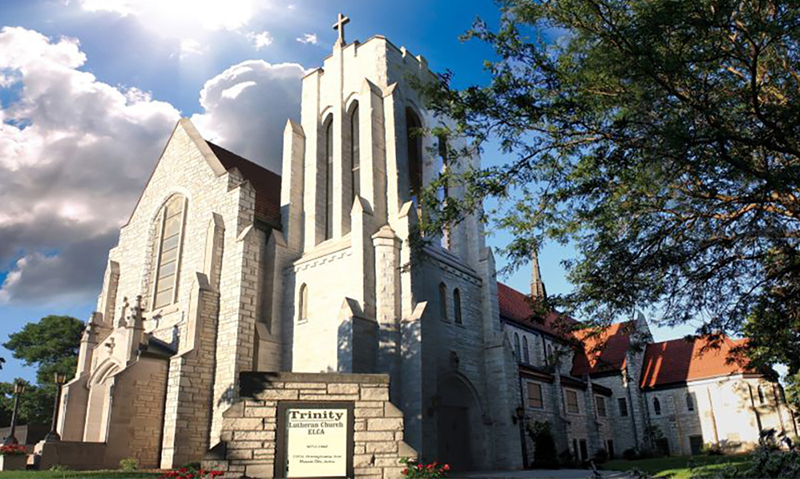History

On July 1st, 1871, members of 16 families signed a Constitution for the Scandinavian Lutheran Church of Mason City. The group of immigrants, mostly from Norway, wanted their children to have baptisms, Sunday School, and services in their native language.
Hard times followed during the years of 1874 – 1906. The congregation was finally able to dedicate its first church building in 1894, and it wasn’t until 1906 that the first resident pastor, Rev. G.G. Belsheim, was installed. Americanization of the congregation began, as some services were held in English, and in 1908 the church name was changed to Trinity Lutheran Church. There was an immediate growth in membership.
During the Great Depression, the congregation exhibited great compassion for the needy, hungry, and unchurched. During the 1920s and 30s, Trinity helped establish Our Savior’s Lutheran in the southwest part of town and expanded Calvary Chapel on the north side to distribute food and clothing and offer spiritual comfort to the poorer sections of town.

Membership at Trinity soared during the 1940s. A new facility was built at the church’s current site, and services were held at the Palace Theater, until the new church was dedicated on May 4th, 1950.
In 1961, the congregation dedicated a three-story education unit and office wing and began a number of ecumenical initiatives in the community. In the 1960s and 70’s, Trinity grew in mission outreach locally and internationally, including the creation of KCMR radio, which went on the air on May 3rd, 1979. Trinity also helped create the Good Shepherd Geriatric Center, and in 1971, combined with other congregations to establish a number of care facilities to help meet the needs of our elderly population.
Over the years, Trinity and its members have been instrumental in the services and agencies for the less fortunate, including Hawkeye Harvest Food Bank, Community Kitchen, Hospice of North Iowa, and the Northern Lights Homeless Shelter, as well as many other agencies and charities. Trinity members have also provided financial assistance to many Lutheran concerns and mission congregations in many parts of the world.
Six years ago, Trinity stood at another crossroads. They recognized the importance of adapting to the needs of a changing culture while modernizing existing facilities; all while remaining a “Servant Church”. A large Renovation and Capital Appeal initiative was launched in 2016. The “T150: For Generations to Come” project aimed to raise $4 million for major building renovation, sanctuary technology, and a development project in Bihar, India, through Lutheran World Relief.

Renovations included an elevator for the education wing and sanctuary, larger rooms for the youth and choir/music, and gathering spaces for connecting after worship. Outdated sound equipment was replaced, and modern technology was installed. When COVID-19 struck, Trinity was prepared and began livestreaming worship in March of 2020.
Along with thriving youth, education, music, and senior adult ministries, Trinity has also recently developed a Faith and Wellness Outreach that includes Healing Touch, mental health initiatives, and community wholeness efforts.
As Trinity Lutheran celebrates 150 years of sharing God’s healing love with many generations, we look further to further God’s Kingdom in our community and the world, both now and in the future.
Women of Trinity History
Women’s Ministry at Trinity has always been a vital part of the church. Before there was a full-time pastor, before there was a church building, before services were held in English, the women of Trinity were organized and preserving the ministry of this congregation. In 1886, an era when women couldn’t vote in this country and only men could serve in church leadership, the Women of Trinity organized as a separate organization. Trinity historian, Zelma Anderson writes of this time in her book, The River. “The history of the country is largely made up of the deeds of men, but the history of a church is mainly visible dees of women: the struggle to maintain a place of worship for themselves and for their children; their endurance and achievement in their kitchens and with their needles; their willingness to take upon their young and old shoulders the preparation of huge church dinners and suppers, busy with their household chores though they were, and with broods of children; but for the best of them and noblest, the labor for the church was love.” For generations, Trinity’s economic viability, hospitality ministries, and mission outreach were based on the efforts of women in the congregation.
Times have changed. We no longer define the gender roles of men and women in society in the same way. Today all people serve as equals in ministry and leadership roles in the church. We invite members to explore all areas of learning, growth, and service based on gifts and desires.